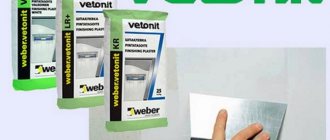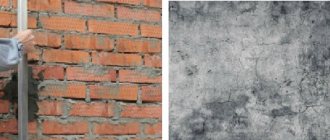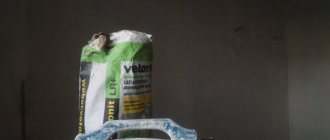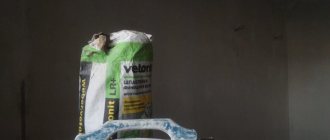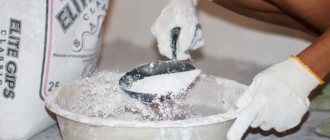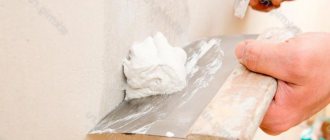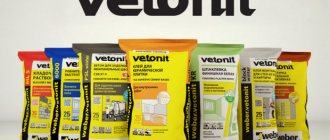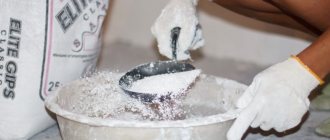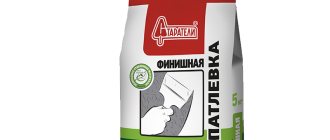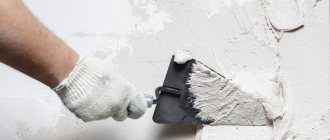Putty is a certain mixture of different fractions and consistencies, which is used to give the surface a more even structure. It performs a preparatory function, allowing you to level the walls for further finishing, be it wallpapering or applying paint. The putty must be of a certain quality and also meet the requirements specified in GOST. The same list of rules contains information about the density of the putty, the time period during which it dries completely, as well as the amount of dry mixture (consumption per 1 m2).
Execution of work
The finished solution is applied to a previously prepared surface by mechanized or manual means. The putty solution is applied to the base and leveled using a two-handed steel spatula. When processing small areas, you can use a metal spatula 30 cm wide. If it is necessary to apply the material in two layers, you should wait until the previous one has completely dried. After application and drying, the surface is treated with sandpaper and removed from dust. And after all the work done and complete drying, the surface is ready for the subsequent application of decorative materials: painting, wallpapering, etc. , and can also be composed in the form of a “fur coat” after the mechanized spraying method.
Vetonit - characteristic features
Vetonit putty occupies a special place in the market of mixtures for leveling walls and other surfaces. There are several varieties of this material.
LR
This mixture is intended for applying the finishing layer. This putty is not suitable for leveling surfaces, but can act as a decorative finish.
Vetonit LR putty is intended for use in dry rooms. It is a finishing putty that is applied before further wallpapering.
The composition of the mixture is quite specific, so it cannot be used to level surfaces with large uneven areas.
The mixture is available in the form of a powder, which must be diluted with a certain amount of liquid, and also in the form of a ready-made mixture, which can be worked with immediately. Here's how to dilute putty.
Vetonit LR
The consumption of Vetonit LR putty is 1.2 kg per square meter. It is worth noting that this standard is the same for all dry mixes from a given manufacturer.
But in practice, everything can turn out differently, because the method of applying the putty, as well as the thickness of the applied layer, plays a significant role.
For more information about Vetonit LR putty, watch the video:
Application of KR putty on walls
This mixture is made on a gypsum basis, and it is intended for work in rooms where there is no humidity.
KR
It is also used more for decorative purposes.
How to calculate the consumption of TT putty on a calculator
It is made on a cement base.
TT
This putty is used to level a wide variety of surfaces - floors, ceilings, walls, etc.
Its quality characteristics allow you to work with it in almost any room.
The consumption of Vetonit putty will depend on a variety of circumstances:
- type of mixture. The consumption of TT index putty will be higher than the consumption of gypsum-based putty. And the consumption of Vetonit LR putty per 1m2 will be less than the amount of gypsum putty used (KR index);
- the specifics of the work itself. The thickness of the layer of ready-made mortar for leveling surfaces will be greater than for decorative finishing;
- surface characteristics. If there are a large number of cracks and seams on the walls and ceiling, this naturally increases the consumption of the mixture;
- number of layers applied. Experts recommend applying at least two layers.
If we talk about average values, then the consumption of Vetonit putty per 1 m2 is from 1 to 1.3 kg. This indicator is also influenced by the method of applying the mixture. If you use a regular spatula to putty walls, the consumption will be high, but if you use a special sprayer, the consumption will be reduced.
The use of this device is possible only with a certain type of putty.
It is worth noting that we are talking about the consumption of dry mixture with a layer thickness of 1 cm.
Considering that experts advise applying at least two layers, the consumption of the finished solution applied to the surface will be exactly doubled.
To accurately determine the consumption of Vetonit putty per 1 m2, you can use the calculator, which is located on the manufacturer’s official website.
There are several main advantages that make Vetonit putty one of the most popular mixtures:
- the finished mixture adheres well to the surface;
- with the exception of gypsum putty, Vetonit can be applied to almost any surface;
- resistance to moisture;
- The applied layer dries quickly enough. Here we talk about how long it takes for the putty to dry.
Safety precautions
The mixture should be stored in a place where children cannot reach. The quality guarantee from the manufacturer applies only if the rules and storage periods are not violated. The powder is created in accordance with GOST 31357-2007, so you need to request a certificate of quality and conformity from the seller before purchasing.
The technician must apply the solution and mix it wearing rubber gloves, protective clothing and goggles.
The technician must apply the solution and mix it wearing rubber gloves, protective clothing and goggles.
Vetonit VX is a high-quality powder mixture for puttying work, which helps to create an even base and obtain a surface prepared for various finishes or cladding. If you carry out the work technology step by step and do not neglect the preparatory actions, the result will be durable and of high quality. The moisture-resistant property of the solution allows it to be used for a variety of rooms.
Types of putty
First, let's get acquainted with the types of putty mixtures.
Starting. Used for initial leveling of the wall surface. It has a coarse-grained structure. The main requirement for it: high levels of adhesion (adhesion to the surface) with uneven application (due to the presence of depressions and irregularities). This roughing product should be selected taking into account the humidity and temperature of the room, as well as the type of material from which the walls and ceilings are made. Usually it is applied in a layer of 3-6 mm.
Finish. Used as the last layer before painting or wallpapering. Thanks to its fine-grained composition, it corrects the smallest imperfections in the wall and makes it perfectly smooth for subsequent finishing. When choosing a finishing putty, you should pay attention to the size of the fraction (the smaller the better) and the compatibility of its composition with wallpaper or paint (otherwise there is a risk of swelling, stains, peeling, bubbles and shrinkage). A type of finishing putty is its improved version - Shitrok putty. The vinyl fibers included in the composition significantly increase performance characteristics.
Universal. The name speaks for itself: the material is suitable for both starting and finishing work. Has medium-grained fractions. With average quality wall leveling is not cheap. Suitable for small amounts of work that do not require special qualifications.
Vetonit. Brand of finishing putties, divided into polymer, cement and gypsum. The binder base of this mixture is polymer glue, cement, gypsum or limestone. They are used both for interior work and for facade processing. Its advantages include:
- fineness;
- environmental friendliness;
- moisture resistance, due to which they can be used even in bathrooms;
- frost resistance.
Price range
Prices for Vetonit dry mixes are quite high and may vary depending on the brand of material. The cost in construction hypermarkets varies between 500-600 rubles per 25 kg.
The goods are packaged in bags of 5 or 25 kg. The product can be stored in its original packaging for 1 year.
Composition and application
The composition of the plaster differs depending on the brand. Vetonit EP is a non-waterproof mixture based on lime and cement. Used for leveling large areas in one go.
It is not recommended to cover structures made of lime or cement-lime compounds.
- The most popular brand is Vetonit TT, its base is cement.
- Dry mixture Vetonit L is a putty on a polymer binder material.
- Vetonit T is based on adhesive organic substances.
- The layer of applied solution is 2-10 mm, maximum 30 mm, depending on the brand of material.
In a dry state, the mixtures are frost-resistant and can withstand 75-100 periods of freezing. The products are in demand in regions with harsh climates.
Putty consumption rates
As mentioned earlier, not only plaster, but also putty can be used to finish and level walls. To determine the thickness of the layer, a standard calculation technique is used using a 4-point suspension (we discussed the calculation algorithm in detail above). In this case, the putty can be applied according to two scenarios:
- Apply universal putty in one layer. Everything is simple here - you apply the same putty in several layers.
- Application of starting and finishing putty. First, starting putty is applied to level the wall. After it has dried, a small layer (2-3 mm) of finishing putty for walls is applied.
Universal putty - consumption per 1 m2
Specific numbers depend on the manufacturer and grain size. Coarse-grained mixtures have a higher consumption, while fine-grained putty is more economical.
Starting putty
The starting mixture should be applied in a thick layer, so to level your home walls you should take at least 2 bags.
Finishing putty
Please note that the finishing mixture is applied in a thin layer (no more than 2 millimeters). Therefore, for home renovations you will not need many bags of finishing putty.
Weber.vetonit tt - weber vetonit
The base must be solid, clean, free from dust and dirt. Substances that weaken adhesion such as grease, dust, etc., as well as water-soluble leveling solutions must be removed. If necessary, dry and absorbent surfaces are moistened. Windows and other untreated surfaces must be carefully protected.
Pour 5-6 liters of clean water into a container and add 25 kg (bag) of weber.vetonit TT
, or 1.0-1.2 liters of water per 5 kg bag, respectively, and the mixture must be added to the water, and not vice versa.
Recommended water temperature is 20°C. Mixing is done with a powerful drill with an attachment for 3-5 minutes. To better dissolve the binder, the mixture is allowed to stand for 10 minutes. After light re-stirring, the mixture is ready for use. The mortar mixture is suitable for use within 3 hours from the moment of mixing with water. The temperature of the mortar mixture should be in the range from +10 to +30 ° C. To increase the wear resistance of the material and improve adhesion, you can replace 10% of the mixing water with weber.vetonit MD16
.
Some tips
Important! The remainder of the solution after finishing work should not be poured into the bathroom or sink.
If you use Vetonit on an adhesive basis, then you can attach the wallpaper when the solution dries well.
How much does it cost to putty walls in St. Petersburg per m2?
Putty consumption, calculation calculator for 1 m2 of wall
Below is a price list for wall plastering work.
| Wall putty | ||
| Name of service | Price | Unit |
| Puttying walls for wallpapering | 280 | m2 |
| Plastering walls for painting | 300 | m2 |
| GKL putty for painting | 280 | m2 |
| Ceiling putty for painting | 280 | m2 |
| Textured putty | from 340 | m2 |
| Dismantling putty | 100 | m2 |
| Putty on window slopes (width no more than 40 cm) | 400 | m.p. |
| Plasterboard putty | 280 | m2 |
| Plastering walls under wallpaper in 2 layers | 450 | m2 |
| Wall putty for painting in 3 layers | 600 | m2 |
| Putty on wall boxes in 2 layers | 400 | m.p. |
| Puttying walls with Shitrok finishing putty | 280 | m2 |
| Finishing putty for semicircular walls | 380 | m2 |
| Sanding walls | 100 | m2 |
| Sanding semicircular walls for wallpaper | 100 | m2 |
